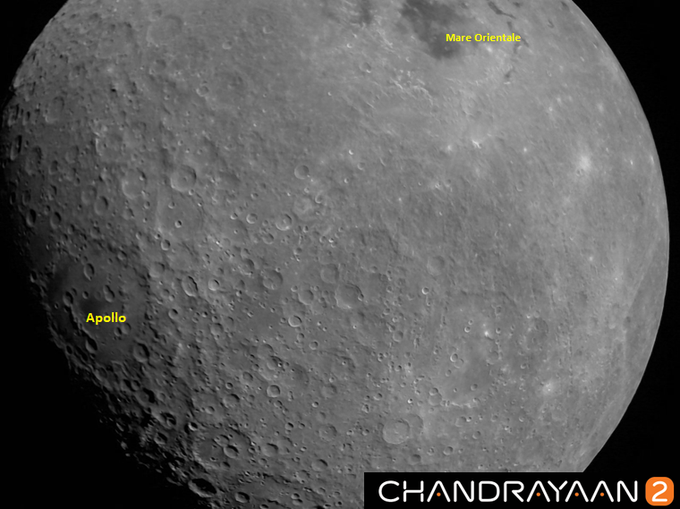
India's historic lunar-landing bid may have come up short, but the nation still has important work to do at the moon.
India's Chandrayaan-2 orbiter attempted to drop a lander named Vikram near the lunar south pole yesterday afternoon (Sept. 6), but mission controllers lost contact with the descending craft when it was just 1.3 miles (2.1 kilometers) above the gray dirt.
As of early Saturday morning (Sept. 7), the Indian Space Research Organisation (ISRO) still had not officially declared Vikram dead. But comments by Indian Prime Minister Narendra Modi leave little room for optimism.
"We came very close, but we will need to cover more ground in the times to come," Modi said during an address to the nation that was webcast live Friday night (Saturday morning India time). "As important as the final result is the journey and the effort. I can proudly say that the effort was worth it, and so was the journey."
Video: The Moment India Lost Contact with the Vikram Moon Lander
Related: India's Chandrayaan-2 Mission to the Moon in Photos
But Chandrayaan-2's journey isn't over yet, because the orbiter is still going strong. In fact, its yearlong moon mission has barely begun; the spacecraft slipped into lunar orbit just last month.
Since then, the Chandrayaan-2 orbiter has been studying Earth's natural satellite with eight different science instruments, from an altitude of 62 miles (100 kilometers). The probe's data should eventually allow researchers to compile detailed maps of the lunar surface, revealing key insights about the moon's elemental composition, formation and evolution, ISRO officials have said.
Some of these maps will attempt to assess the moon's stores of water ice. A decade ago, Chandrayaan-2's predecessor, the orbiter Chandrayaan-1, showed that water is widespread across the lunar surface, especially at the poles. (A NASA instrument aboard Chandrayaan-1 called the Moon Mineralogy Mapper made the key observations for this discovery.)
Get the Space.com Newsletter
Breaking space news, the latest updates on rocket launches, skywatching events and more!
Subsequent work has suggested that much of this water is ice on the floors of polar craters, which have been in permanent shadow for billions of years. If this ice is easily accessible, it could be a critical enabling resource for the eventual human settlement of the moon.
That's the main reason lunar-exploration advocates have homed in on the south polar region, which appears to harbor considerably more water ice than the north. Indeed, NASA intends to send resource-scouting instruments to the south pole aboard commercial landers in the next few years and to land two astronauts there by 2024.
These NASA activities are part of a program called Artemis, which aims to establish a sustainable, long-term presence on and around the moon by 2028. The skills and lessons learned in making this happen will enable the agency to make the crewed leap to Mars in the 2030s, NASA officials say.
Chandrayaan-2's surface work would have contributed some useful information to Artemis' planners, and anyone else interested in knowing more about lunar water. Vikram was supposed to deploy a rover named Pragyan, which would have mapped out the elemental composition of the landing site, potentially providing up-close information about ice in the area.
Vikram's apparent lunar crash is the second in less than five months. The Beresheet lander, which was operated by the Israeli nonprofit SpaceIL and its partner Israel Aerospace Industries, failed during its touchdown attempt on April 11, slamming hard into the lunar surface.
Only three nations have succeeded in landing a probe softly on the moon to date: the Soviet Union, the United States and China.
- Stunning Photos Show Earth from India's Spacecraft Headed to the Moon
- India's Space Program (Topic Page)
- India's Chandrayaan-2 Spacecraft Snaps Its First Picture of the Moon
Mike Wall's book about the search for alien life, "Out There" (Grand Central Publishing, 2018; illustrated by Karl Tate), is out now. Follow him on Twitter @michaeldwall. Follow us on Twitter @Spacedotcom or Facebook.
Join our Space Forums to keep talking space on the latest missions, night sky and more! And if you have a news tip, correction or comment, let us know at: community@space.com.

Michael Wall is a Senior Space Writer with Space.com and joined the team in 2010. He primarily covers exoplanets, spaceflight and military space, but has been known to dabble in the space art beat. His book about the search for alien life, "Out There," was published on Nov. 13, 2018. Before becoming a science writer, Michael worked as a herpetologist and wildlife biologist. He has a Ph.D. in evolutionary biology from the University of Sydney, Australia, a bachelor's degree from the University of Arizona, and a graduate certificate in science writing from the University of California, Santa Cruz. To find out what his latest project is, you can follow Michael on Twitter.









